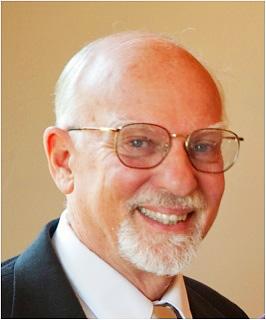A road accident in Taipei earlier this month that killed US neuroscientist Bruce Bridgeman occurred because he was apparently confused by traffic on Renai Road, police said yesterday.
Taipei Medical University said that the accident happened on the morning of July 10 and that Bridgeman had been scheduled to visit the school to give a speech.
Following a preliminary review of footage taken from a bus’ video recorder, Chang Yu-hao (張育豪), head of the Taipei Police Department’s Traffic Division, said that Bridgeman was crossing Renai Road when he was struck by an oncoming bus, apparently because he was minding traffic to his left, but did not see the bus, which was coming down a bus lane to his right.

Photo: Screen grab from the Web site of the University of California, Santa Cruz
The accident could have been due in part to trees planted on the road, which could have obstructed Bridgeman’s view, Chang said.
Bridgeman was rushed to hospital, but died of an intracranial hemorrhage, Chang said.
He said that traffic on Renai Road, which has as many as eight lanes, was different from that on other arteries in that cars can go only one way, but buses travel both ways, which could have confused Bridgeman and led to the mishap.
The bus belonged to Taipei Bus Co (台北客運) and the case is being investigated to work out the liabilities connected to the accident, Taipei Public Transportation Office Chief Secretary Yang Ching-wen (楊清文) said.
Taipei Mayor Ko Wen-je (柯文哲) yesterday said that the accident showed that the traffic signs on Renai Road could be improved.
Ko said that since most traffic signs are in Chinese, Bridgeman probably did not realize that some buses were going in an opposite direction to the cars.
“We need to figure out ways to let foreign visitors understand the signs, even though they are in Chinese,” Ko said.
University of California, Santa Cruz, where Bridgeman was a professor emeritus, said that Bridgeman was on a speaking tour of Asia with his wife at the time of the accident.
He was an internationally renowned researcher of neuroscience and spatial orientation.

STILL COMMITTED: The US opposes any forced change to the ‘status quo’ in the Strait, but also does not seek conflict, US Secretary of State Marco Rubio said US President Donald Trump’s administration released US$5.3 billion in previously frozen foreign aid, including US$870 million in security exemptions for programs in Taiwan, a list of exemptions reviewed by Reuters showed. Trump ordered a 90-day pause on foreign aid shortly after taking office on Jan. 20, halting funding for everything from programs that fight starvation and deadly diseases to providing shelters for millions of displaced people across the globe. US Secretary of State Marco Rubio, who has said that all foreign assistance must align with Trump’s “America First” priorities, issued waivers late last month on military aid to Israel and Egypt, the

France’s nuclear-powered aircraft carrier and accompanying warships were in the Philippines yesterday after holding combat drills with Philippine forces in the disputed South China Sea in a show of firepower that would likely antagonize China. The Charles de Gaulle on Friday docked at Subic Bay, a former US naval base northwest of Manila, for a break after more than two months of deployment in the Indo-Pacific region. The French carrier engaged with security allies for contingency readiness and to promote regional security, including with Philippine forces, navy ships and fighter jets. They held anti-submarine warfare drills and aerial combat training on Friday in

COMBAT READINESS: The military is reviewing weaponry, personnel resources, and mobilization and recovery forces to adjust defense strategies, the defense minister said The military has released a photograph of Minister of National Defense Wellington Koo (顧立雄) appearing to sit beside a US general during the annual Han Kuang military exercises on Friday last week in a historic first. In the photo, Koo, who was presiding over the drills with high-level officers, appears to be sitting next to US Marine Corps Major General Jay Bargeron, the director of strategic planning and policy of the US Indo-Pacific Command, although only Bargeron’s name tag is visible in the seat as “J5 Maj General.” It is the first time the military has released a photo of an active

CHANGE OF MIND: The Chinese crew at first showed a willingness to cooperate, but later regretted that when the ship arrived at the port and refused to enter Togolese Republic-registered Chinese freighter Hong Tai (宏泰號) and its crew have been detained on suspicion of deliberately damaging a submarine cable connecting Taiwan proper and Penghu County, the Coast Guard Administration said in a statement yesterday. The case would be subject to a “national security-level investigation” by the Tainan District Prosecutors’ Office, it added. The administration said that it had been monitoring the ship since 7:10pm on Saturday when it appeared to be loitering in waters about 6 nautical miles (11km) northwest of Tainan’s Chiang Chun Fishing Port, adding that the ship’s location was about 0.5 nautical miles north of the No.